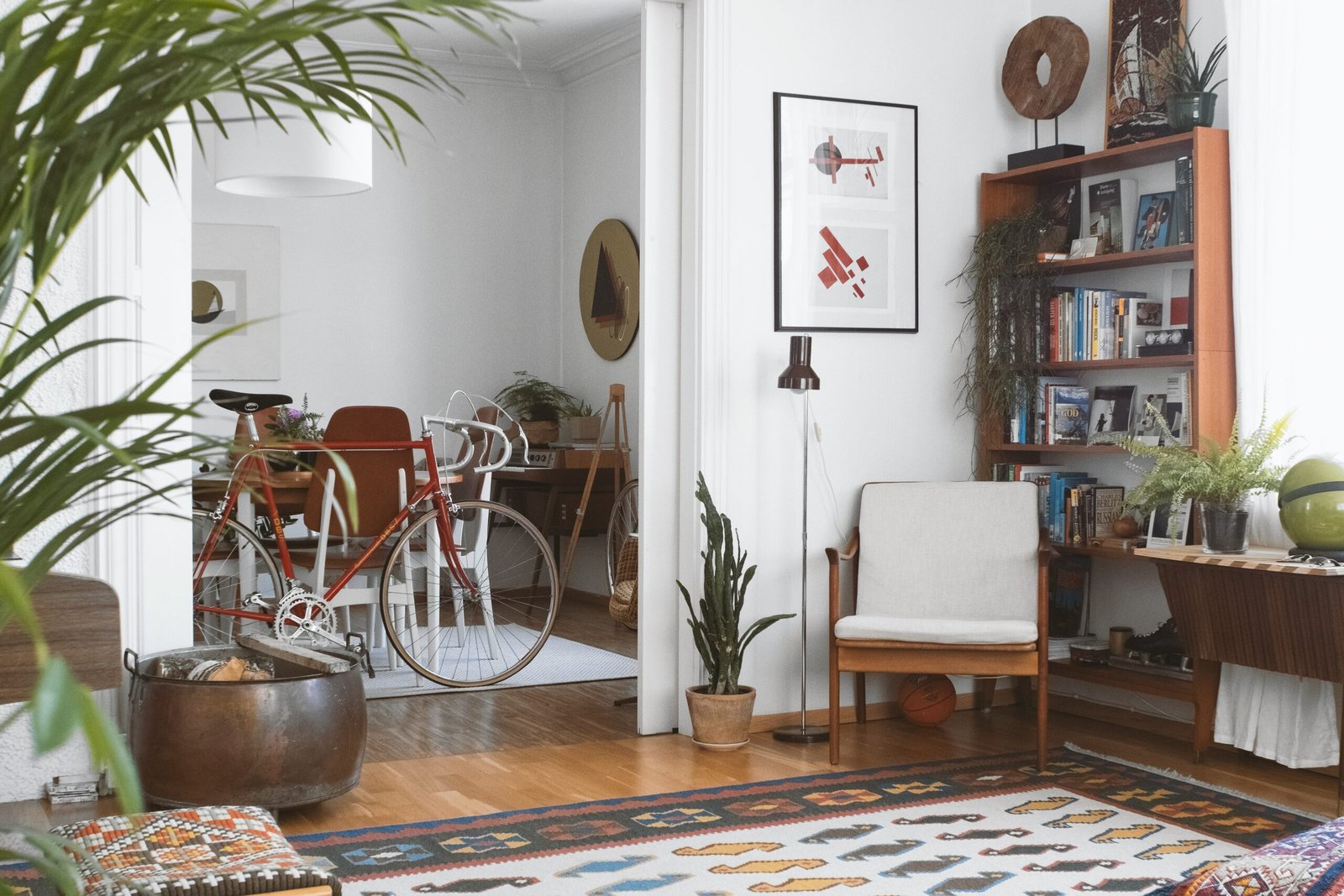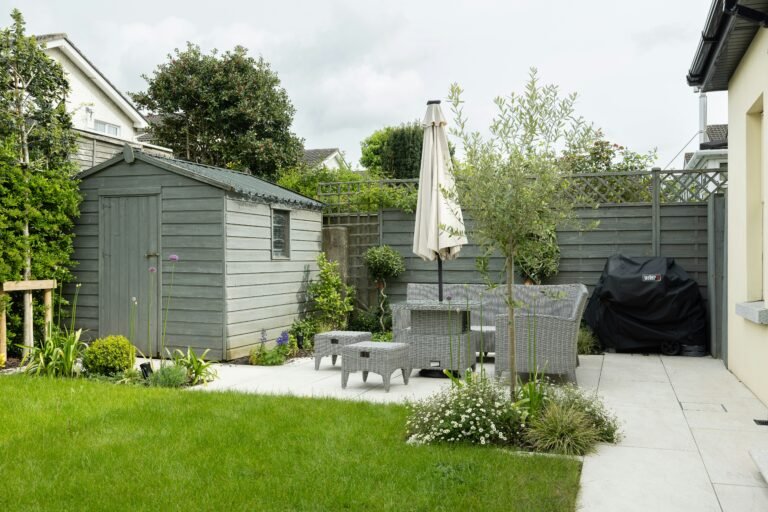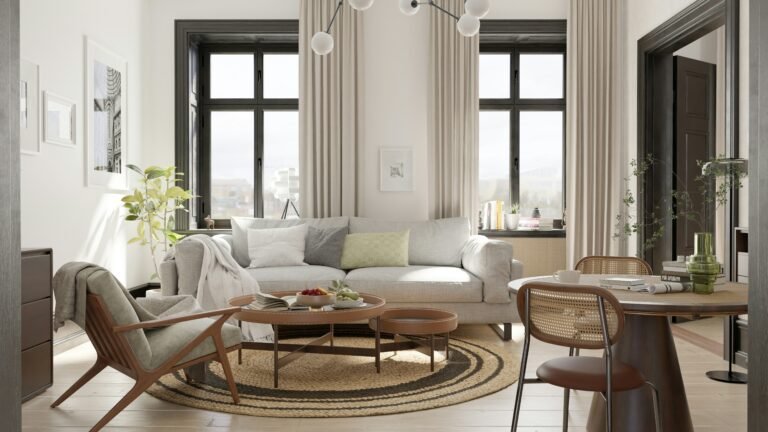Few design movements have left as lasting an impact as Mid-Century Modern. Emerging in the years after World War II, this style reshaped homes, furniture, and architecture with its focus on simplicity, clean lines, and functionality. From the sculptural curves of an Eames chair to the seamless connection between indoor and outdoor living, Mid Century Modern captured the optimism of a new era while setting a timeless design standard that continues to influence our spaces today.
I have always been drawn to its balance of beauty and practicality. When I first encountered a classic piece of mid century furniture at a vintage market, I was struck by how something created more than half a century ago still felt fresh and relevant. That experience made me realize that this style is more than a trend, it is a design philosophy rooted in functionality, comfort, and enduring elegance.
In this article, we will explore what defines Mid Century Modern, its key characteristics, the most iconic mid century pieces, and the architectural landmarks that gave it shape. You will also find practical mid century home tips on how to bring this look into your own space today. Whether you are a design enthusiast or simply curious about the movement, this guide will help you understand why Mid Century Modern remains one of the most influential styles of the 20th century.
What Is Mid Century Modern
At its core, Mid Century Modern is a design movement that flourished from the mid-1940s through the late 1960s. It was born out of a unique cultural moment: the optimism of the postwar years, rapid suburban growth, and the desire for functional yet beautiful homes that reflected a modern way of living. Unlike ornate traditional styles, Mid Century Modern emphasized clean lines, uncluttered spaces, and a seamless connection between indoors and outdoors.
The term itself was popularized by author Cara Greenberg in her 1984 book Mid-Century Modern: Furniture of the 1950s. Since then, it has come to describe a broad aesthetic that includes not only furniture but also architecture, interiors, and even graphic design. According to Architectural Digest, architects like Richard Neutra and Ludwig Mies van der Rohe introduced sleek, glass-heavy homes that blended harmoniously with their natural surroundings. At the same time, designers such as Charles and Ray Eames, Eero Saarinen, and Isamu Noguchi crafted furniture that was functional, sculptural, and accessible—pieces that are still celebrated as iconic mid century furniture today.
What sets Mid Century Modern apart is its focus on problem-solving through design. The use of innovative materials like molded plywood, fiberglass, and steel allowed for new shapes and lighter, more affordable furniture. As The Spruce notes, natural woods such as teak and rosewood were paired with industrial elements to strike a balance between warmth and innovation. This blend of the organic and the modern remains one of the hallmarks of the style.
Personally, I think what makes Mid Century Modern fascinating is its versatility. A single piece, say, a Noguchi coffee table can feel at home in a minimalist apartment, a bohemian loft, or a contemporary suburban house. The style is adaptable because it was never about decoration for decoration’s sake. Instead, it was about creating designs that improved how people lived, something that feels just as relevant today as it did in the 1950s.
By understanding its roots, we can better appreciate why Mid Century Modern continues to inspire new generations of designers and homeowners alike. It is not simply a vintage trend but a lasting expression of modern living, as highlighted by Vogue.
➡️ Another Minimalist Style: Scandinavian Interior Design: Blending Simplicity, Comfort and Function
Key Characteristics That Define the Style
The beauty of Mid Century Modern lies in its recognizable design language. Whether it is a home, a chair, or a lighting fixture, certain characteristics immediately signal the style. These traits not only shaped the aesthetic of the 20th century but continue to influence interiors today.
Clean Lines and Geometric Forms
At the heart of Mid Century Modern is simplicity. Designers stripped away heavy ornamentation in favor of streamlined forms. According to BBC Maestro, angular silhouettes and geometric patterns created a look that was both practical and visually striking. The result was furniture and architecture that felt light, open, and timeless.
Functionality First
One of the reasons iconic mid century pieces remain relevant is their emphasis on usability. As Vogue notes, designers treated furniture as problem-solving tools rather than decorative objects. Every curve of an Eames Lounge Chair or every leg angle on a Saarinen table was carefully considered to serve the person using it.
Natural and Innovative Materials
This style combined the best of both worlds: natural woods like teak, walnut, and rosewood with manmade innovations such as fiberglass, plywood, and vinyl. As The Spruce explains, these materials allowed for designs that were durable yet elegant, affordable yet beautiful.
➡️ More on this topic: How to Mix Wood Tones in Your Home Without Clashing
Connection to Nature
Another defining element was the integration of indoor and outdoor living. Homes often featured floor-to-ceiling glass, sliding doors, and open layouts that blurred the boundaries between interior comfort and the natural world outside. Architectural Digest highlights how this principle remains deeply influential in contemporary architecture.
Bold Yet Grounded Color Palettes
While much of Mid Century Modern furniture emphasized natural wood tones, designers were not afraid of color. Accent walls, rugs, and upholstery often introduced bold shades like mustard yellow, burnt orange, or avocado green. These hues, as Homes & Gardens points out, gave spaces personality without overwhelming the clean-lined foundation.
Personally, I have always admired how these elements come together effortlessly. When I first placed a teak credenza against a white wall in my own home, the contrast instantly added warmth and sophistication without needing any extra decoration. That is the magic of Mid Century Modern—it achieves balance between minimalism and livability.
Iconic Mid Century Modern Pieces and Architecture
The most memorable way to understand Mid Century Modern is through the furniture and buildings that defined it. These creations are not just relics of the past—they are enduring works of art that continue to inspire collectors, homeowners, and designers today.

Furniture Icons
Some of the most iconic mid century pieces are still instantly recognizable:
- Eames Lounge Chair and Ottoman
Designed by Charles and Ray Eames in 1956, this chair is often called the epitome of Mid Century Modern luxury. Its combination of molded plywood, supple leather, and ergonomic comfort has earned it a permanent spot in the Museum of Modern Art’s collection. Wikipedia provides a fascinating look at its history and influence. - Noguchi Coffee Table
Isamu Noguchi’s sculptural table paired a curved wooden base with a freeform glass top. This balance of organic shape and practicality made it a staple for mid century furniture lovers. - Tulip Table
Eero Saarinen sought to “clear up the slum of legs” with his pedestal-based Tulip Table. Its sleek, futuristic silhouette remains a favorite for dining rooms worldwide. - Arco Floor Lamp
Designed by Achille and Pier Giacomo Castiglioni in 1962, this lamp’s sweeping arc and marble base allowed light to be positioned without overhead fixtures, a revolutionary idea at the time.
Architectural Landmarks
Mid Century Modern was not limited to interiors; it also redefined residential and commercial architecture. According to Architectural Digest, these structures embodied simplicity, transparency, and a deep connection to their environment.
- Farnsworth House by Ludwig Mies van der Rohe
Located in Plano, Illinois, this glass-and-steel masterpiece exemplifies the minimalist ideals of the movement. - Kaufmann House by Richard Neutra
Built in Palm Springs in 1946, this desert home integrated natural stone, expansive glass, and flat planes to merge luxury with the harsh beauty of the desert. - Elrod House by John Lautner
Famous for its circular concrete roof and massive glass walls, this Palm Springs landmark demonstrates the dramatic potential of Mid Century Modern architecture.
I remember the first time I visited a mid century home in California: the walls of glass made it feel like the living room stretched into the garden itself. It was a striking reminder that MCM architecture was not just about form but about enhancing daily life.
These pieces and buildings show why Mid Century Modern is more than a passing style. They remain relevant because they solved problems of their time, comfort, function, integration with nature while still feeling timeless in today’s world.
Why the Style Keeps Reigning
Decades after its peak, Mid Century Modern continues to dominate design magazines, furniture showrooms, and Pinterest boards. What makes this style so enduring? The answer lies in its versatility, functionality, and timeless appeal.
Timeless Versatility
One of the reasons Mid Century Modern has never faded is its ability to adapt. Whether you live in a city loft, a suburban ranch, or a modern condo, its pieces fit seamlessly into different environments. As Homes & Gardens points out, the clean lines and restrained forms act as a neutral canvas that blends with other aesthetics – Scandinavian, industrial, bohemian, or even traditional.
Personally, I’ve noticed that a single mid century furniture item, like an Eames molded chair, can update a room instantly without requiring a full redesign. That kind of flexibility is rare in design.
Function and Comfort
Designers of the movement believed furniture should improve everyday life. According to Vogue, this human-centered philosophy is why pieces like the Eames Lounge Chair still feel comfortable and modern decades later. They were created not just to be admired but to be lived in, making them as practical today as they were in the 1950s.
Sustainable and Durable
In an age where sustainability matters more than ever, the use of solid woods, durable upholstery, and timeless construction makes iconic mid century pieces appealing for eco-conscious homeowners. As The Spruce explains, many vintage MCM pieces are still in excellent condition thanks to their craftsmanship, proof that good design lasts.
Aesthetic Harmony
Another reason Mid Century Modern thrives is its focus on balance. Open layouts, large windows, and indoor-outdoor connections foster a sense of harmony that feels grounding in today’s fast-paced world. Architectural Digest highlights how these principles continue to influence contemporary architecture, proving that MCM ideas were not bound to a single era.
What I find most powerful is how this style manages to feel both nostalgic and forward-looking. When I sit at a sleek walnut dining table surrounded by natural light, I feel connected to the optimism of the mid-20th century while also embracing a design philosophy that still feels progressive. That duality is why Mid Century Modern has not just survived. It has reigned for more than half a century.
Tips for Bringing Mid Century Modern into Your Home
One of the most exciting things about Mid Century Modern is how easy it is to incorporate into a contemporary space. You do not need to redesign your entire house to capture the essence of this style. With a few thoughtful choices, you can bring its timeless charm into your own home.

Start Small with Statement Pieces
If you are new to the style, begin with a single piece of mid century furniture, a walnut sideboard, a molded plastic chair, or a low-slung sofa. As Vogue notes, even one authentic piece can transform a room, acting as an anchor that sets the tone for the rest of your décor.
Mix Old with New
Do not feel pressured to fill your home entirely with vintage finds. In fact, blending modern items with iconic mid century pieces often creates the most interesting results. Homes & Gardens suggests pairing a classic Eames chair with a contemporary sofa or updating a vintage dining table with modern lighting to keep the look fresh.
Embrace Nature Indoors
Because Mid Century Modern homes often blurred indoor and outdoor spaces, you can recreate the effect with greenery. As Spark Interiors points out, indoor plants not only add vibrancy but also echo the organic philosophy behind MCM design. Large windows, natural light, and earthy textures can reinforce that connection.
Be Mindful of Scale
One design tip I learned firsthand: mid century furniture often sits lower to the ground and features angled legs. In small rooms, too many low pieces can make the space feel crowded. Designer Maria Killam warns against overusing these proportions, recommending balance with taller or sleeker items to maintain harmony (Maria Killam).
Choose Quality Over Quantity
Authentic pieces can be pricey, but investing in one well-made item is usually more impactful than filling a room with replicas. According to The Spruce, many cheap “mid century inspired” products lose the integrity of the original design. Whenever possible, seek out reputable vintage shops, auctions, or quality reproductions.
In my own home, I started with just one teak credenza. Over time, I layered in a Noguchi-style lamp and a few vintage ceramics. Each addition felt like a piece of history, yet the overall look stayed uncluttered and modern. That’s the beauty of Mid Century Modern, you can build it gradually, making it personal and timeless at the same time.
Designer Insights and Modern Interpretations
While the golden age of Mid Century Modern spanned the 1940s to the 1960s, its influence is far from over. Today’s designers and homeowners continue to reinterpret the movement, blending its principles with contemporary living. The result is a style that feels both nostalgic and fresh.
Contemporary Designers Reviving the Look
According to Homes & Gardens, many interior designers still rely on mid century furniture as a foundation for modern spaces. Jonathan Adler, for example, frequently integrates iconic silhouettes like Saarinen’s Tulip Table or Eames chairs into bold, colorful interiors. This shows how iconic mid century pieces can hold their own while adapting to playful modern updates.
Similarly, Los Angeles–based designer Molly Purnell has spoken about the enduring relevance of MCM design. She emphasizes that its principles, clean lines, functional layouts, and indoor-outdoor connections make it an ideal blueprint for contemporary living (Vogue).
MCM Architecture Today
It’s not just furniture, MCM architecture remains deeply influential. Developers and homeowners are renovating original mid century homes with respect for their heritage while upgrading them for modern comfort. As Architectural Digest highlights, the emphasis on open floor plans and walls of glass still resonates with today’s preference for natural light and flow.
In my own experience, stepping into a restored mid century home feels like time travel with a modern twist. You get the warmth of history but with energy-efficient windows, updated kitchens, and smarter layouts that make the style practical for today’s families.
Modern Interpretations
What I find particularly inspiring is how younger designers reinterpret the style without copying it outright. Some might use sustainable woods and minimalist forms to echo the mid century home tips we’ve discussed, while others might play with retro color palettes in unexpected ways. The balance between respecting tradition and pushing boundaries keeps the style evolving.
As Wikipedia notes, Mid Century Modern has become a global reference point in design history. But rather than being locked in the past, it thrives because each generation finds new relevance in its ideas.
In many ways, Mid Century Modern is no longer just a design movement, it is a language. Designers continue to speak it, whether subtly through a walnut chair leg or boldly with a glass-walled home. Its adaptability ensures that this iconic style will never truly fade.
Conclusion
Looking back across decades of influence, it is clear that Mid Century Modern was more than just a design trend, it was a cultural movement that reshaped how people lived. By prioritizing clean lines, functional furniture, and a seamless relationship with nature, it created a design language that still feels contemporary in today’s world.
What makes this style endure is its balance of practicality and beauty. From the comfort of an Eames Lounge Chair to the airy openness of a glass-walled home, its designs continue to embody comfort, simplicity, and timelessness. As Architectural Digest and Vogue have noted, MCM principles remain as relevant to today’s interiors as they were to postwar homes.
For anyone looking to incorporate this aesthetic, the key lies in being intentional. A single piece of mid century furniture, a few iconic mid century pieces, or thoughtful mid century home tips can transform a space without overwhelming it.
On a personal note, I see Mid Century Modern as more than a style. To me, it represents an ethos of thoughtful living, design that serves people first, while still inspiring wonder. That is why, even in a world of ever-changing trends, Mid Century Modern continues to reign as one of the most iconic and influential styles of the 20th century.
Frequently Asked Questions About Mid Century Modern
Alex is the creator of Homely Haven, a space dedicated to simple, stylish ideas for interiors and gardens alike. With a passion for cozy living rooms, inviting outdoor spaces, and practical DIY solutions, Alex shares tips and guides that help turn any house into a true home.
From budget-friendly decorating hacks to weekend garden projects, the goal is always the same: to inspire you to create spaces that feel personal, beautiful, and welcoming. When not writing, Alex is usually rearranging furniture, sketching new garden layouts, or exploring design trends for the next project.








